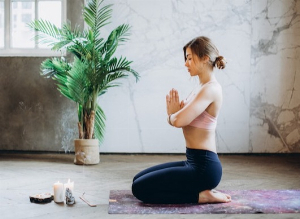Yoga - Supporting women with endometriosis / adenomyosis
Published Jan 20, 2023 • By Candice Salomé
Endometriosis/adenomyosis is a complex disease with a variety of symptoms that affects approximately 1 in 10 women of reproductive age. Its impact on the quality of life of patients is significant.
Yoga is increasingly popular to relieve pain related to endometriosis but also to reconnect with oneself.
But how can we improve the quality of life of patients with endometriosis/adenomyosis? How can yoga help in the management of endometriosis/adenomyosis?
We tell you everything in our article!

What is endometriosis?
Endometriosis/adenomyosis is a chronic condition that can cause severe pain during menstruation and outside of menstruation. This pain can extend from the lower back to the cervicals, in the thighs, during sexual intercourse and/or during defecation. Endometriosis can also cause digestive problems such as bloating, including "endobelly" (severe bloating, very swollen and hard stomach), alternating constipation/diarrhea, urinary pain, recurrent migraines, chronic fatigue, etc. This pathology can have an impact on all areas of life (personal, professional, intimate, etc.).
Each woman has her own endometriosis/adenomyosis. This pathology plays a role in the whole body, so it cannot be reduced to a pathology of the gynecological sphere alone.
It is essential to be accompanied by a multidisciplinary team : a specialized gynecologist as a priority and then, depending on the symptoms felt, the needs and expectations of the patient, a physiotherapist and/or osteopath, a dietician-nutritionist, an internal physiotherapist.
Indeed, Yoga is being more appreciated by the medical community and is proving to be a tool that can really play a role in the quality of life of patients. Yoga (postural practice and meditation in a personalized and individualized way) is a real support to relieve pain and discomfort of everyday life, to feel better on all levels (physical, emotional ...), and to reconnect to their bodies when patients often disconnect because of the pain they feel.
What is yoga?
Yoga could be translated as "joining" or "union". It is the union of body, heart and mind. Yoga includes postural practice, meditation and philosophy.
The postural practice
Postural practice combines movement and body awareness. The breath is the conductor. The postures are carefully chosen and totally adapted to each person, so that they can find what they are looking for and much more. Listening, kindness, respect for the body and the person are priorities. There are no prerequisites to practice yoga. The practice must be accessible and adapted to each person.
If certain postures are not adapted, they can generate more stress than anything else and become deleterious. This is why it is essential to individualize and personalize the practice. In the beginning, yoga was taught individually.
Meditation
Meditation is a part of yoga. There are hundreds of ways to meditate. We can also meditate standing, lying down, sitting, walking or eating. To meditate is to welcome oneself as one is by paying attention to it (mindfulness). We welcome what is, at this moment.
Meditation does not aim to stop thinking. We have an average of 45 to 60,000 thoughts per day. Moreover, there is no specific objective in meditating. Just be yourself and let yourself be guided, you will feel the benefits in any case.
The philosophy of yoga
Yoga philosophy is rich in teachings, if it is democratized and secularized. It allows us to understand ourselves better, to know ourselves better, to live better with others and with ourselves (kindness towards ourselves and towards others, to welcome what is at this moment...). When we have been suffering for several years, we tend not to listen to ourselves, to force ourselves on a daily basis to keep our professional and personal commitments. This is not always easy. Yoga allows us to come back to ourselves, to our needs and expectations, to better understand ourselves, to better listen to ourselves without ever forcing ourselves. It is a real learning process that is lived on the mat and the outside, on a daily basis.
What are the benefits of yoga for pain related to endometriosis/adenomyosis?
To be more serene on a daily basis (reduce stress and anxiety)
The inflammation generated by endometriosis/adenomyosis plays a big role in stress hormones. On a daily basis, we experience stressful situations (professional and/or personal situations). We cannot avoid stress. In fact, stress is not negative in itself. It allows us to adapt to a new context. That said, we tend to stay in a state of alertness over the long term. Yoga will allow you to reconnect to yourself, to your body, to the present moment. This plays a role on the emotional state, and allows to regulate the nervous system while reducing inflammation (we release anti-inflammatory endorphins) and thus helps to regulate chronic stress.
Relieve pain and discomfort
Yoga is an excellent complement to medical care. Postural practice and meditation, along with breathing exercises, help to alleviate chronic pain and relax the body over the long term. In fact, hospitals are increasingly recommending yoga for patients with chronic conditions.
Yoga has an impact on the whole person and on all the major systems of the body: the musculoskeletal, nervous, respiratory, digestive systems... it is important to remember this.
Regain mobility in the pelvis and in the whole body
Yoga stretches the muscles, strengthens the body gently, plays on the visceral system, the fascias... The list goes on. In the context of endometriosis, we often tend to avoid movement when faced with the pain we feel. Mobility of the body and pelvis is really necessary. For example, certain postures and abdominal breathing will affect the digestive system or free up the diaphragm - a large key muscle for breathing, often abused by stress. It is directly connected to the spine and the visceral system. Good to know: we can also suffer from endometriosis in the diaphragm.
A global wellness
Postural practice and meditation allow us to feel better through whole (body, mind and emotions). We feel good in our body, we gain perspective on external events.. Moreover, we have tools to relieve the pains in case of crisis. We untie tensions and relax every part of the body. The well-being hormones are stimulated. It is a virtuous circle.
Getting to know yourself on all levels
Yoga, as a whole, does not only play a role on the body. It is a holistic approach to overall wellness. Women with endometriosis/adenomyosis tend to disassociate themselves from their bodies in the face of pain. Here, a whole process is put in place to (re)discover themselves. It is therefore an excellent way to reconnect with oneself.
Relieve chronic fatigue
Adapted and personalized postural practice and meditation allow you to regain energy, release tension and regenerate yourself. It is therefore an excellent way to recover physically, emotionally and mentally.
The list could be much longer, as the benefits of yoga are numerous. Give it a try and you'll discover them as you go along!
Did you like this article?
Click on "Like" or share your feelings and questions with the community in the comments below!
Take care of yourself!
Comments
You will also like

Endometriosis and digestive issues: Understanding causes and symptoms for better relief!
Oct 23, 2024

 Facebook
Facebook Twitter
Twitter

